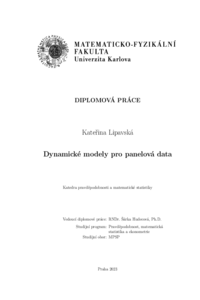Dynamické modely pro panelová data
Dynamic panel data models
diploma thesis (DEFENDED)

View/
Permanent link
http://hdl.handle.net/20.500.11956/182217Identifiers
Study Information System: 250115
Collections
- Kvalifikační práce [11327]
Author
Advisor
Referee
Hušková, Marie
Faculty / Institute
Faculty of Mathematics and Physics
Discipline
Probability, Mathematical Statistics and Econometrics
Department
Department of Probability and Mathematical Statistics
Date of defense
15. 6. 2023
Publisher
Univerzita Karlova, Matematicko-fyzikální fakultaLanguage
Czech
Grade
Excellent
Keywords (Czech)
panelová data|dynamický model|první diference|zobecněná metoda momentůKeywords (English)
panel data|dynamic model|first differences|generalized method of momentsPráce se zabývá dynamickým modelem pro panelová data a odhady jeho parame- trů. Nejprve jsou zopakovány odhady pro lineární regresní model a zobecněná metoda momentů. Dále jsou uvedeny klasické odhady pro model panelových dat a zdůvodnění nevhodnosti použití těchto odhadů na dynamický model panelových dat. Následně jsou ukázány dvoustupňové odhady a odhady zobecněnou metodou momentů vhodné pro dy- namický model, jmenovitě Arellanův-Bondův, Arellanův-Boverův a Ahnův-Schmidtův odhad. V závěru jsou na základě Monte Carlo simulační studie ověřeny vybrané teore- tické výsledky a je porovnáno chování odhadů uvedených v práci pro různá nastavení. 1
This thesis deals with a dynamic panel data model and parameters estimation in these models. First, estimation of parameters in linear regression models is revised as well as ge- neralized method of moments. Second, classical estimation methods for panel data model are considered and it is shown why they are inappopriate to use for dynamic panel data model. Subsequently, two-stage least squares estimation method and estimators based on generalized method of moments are presented, namely Arellano-Bond, Arellano-Bover and Ahn-Schmidt estimators. Some of the theoretical results are illustrated in a Monte Carlo simulation study, which also compares behaviour of the presented estimators under various settings. 1
